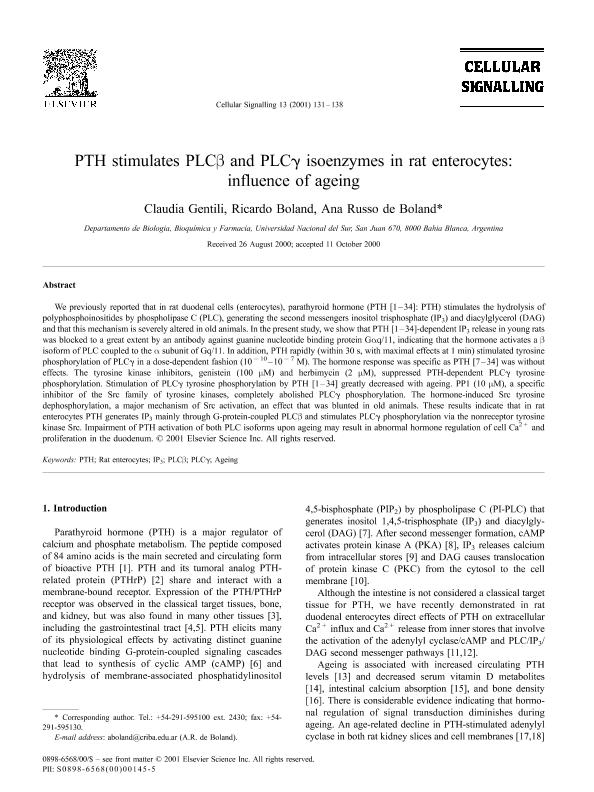Mostrar el registro sencillo del ítem
dc.contributor.author
Gentili, Claudia Rosana

dc.contributor.author
Boland, Ricardo Leopoldo

dc.contributor.author
Russo, Ana Josefa

dc.date.available
2018-03-28T14:21:31Z
dc.date.issued
2001-02
dc.identifier.citation
Gentili, Claudia Rosana; Boland, Ricardo Leopoldo; Russo, Ana Josefa; PTH stimulates PLCβ and PLCγ isoenzymes in rat enterocytes: influence of ageing; Elsevier Science Inc; Cellular Signalling; 13; 2; 2-2001; 131-138
dc.identifier.issn
0898-6568
dc.identifier.uri
http://hdl.handle.net/11336/40351
dc.description.abstract
We previously reported that in rat duodenal cells (enterocytes), parathyroid hormone (PTH [1–34]: PTH) stimulates the hydrolysis of polyphosphoinositides by phospholipase C (PLC), generating the second messengers inositol trisphosphate (IP3) and diacylglycerol (DAG) and that this mechanism is severely altered in old animals. In the present study, we show that PTH [1–34]-dependent IP3 release in young rats was blocked to a great extent by an antibody against guanine nucleotide binding protein Gαq/11, indicating that the hormone activates a β isoform of PLC coupled to the α subunit of Gq/11. In addition, PTH rapidly (within 30 s, with maximal effects at 1 min) stimulated tyrosine phosphorylation of PLCγ in a dose-dependent fashion (10−10–10−7 M). The hormone response was specific as PTH [7–34] was without effects. The tyrosine kinase inhibitors, genistein (100 μM) and herbimycin (2 μM), suppressed PTH-dependent PLCγ tyrosine phosphorylation. Stimulation of PLCγ tyrosine phosphorylation by PTH [1–34] greatly decreased with ageing. PP1 (10 μM), a specific inhibitor of the Src family of tyrosine kinases, completely abolished PLCγ phosphorylation. The hormone-induced Src tyrosine dephosphorylation, a major mechanism of Src activation, an effect that was blunted in old animals. These results indicate that in rat enterocytes PTH generates IP3 mainly through G-protein-coupled PLCβ and stimulates PLCγ phosphorylation via the nonreceptor tyrosine kinase Src. Impairment of PTH activation of both PLC isoforms upon ageing may result in abnormal hormone regulation of cell Ca2+ and proliferation in the duodenum.
dc.format
application/pdf
dc.language.iso
eng
dc.publisher
Elsevier Science Inc

dc.rights
info:eu-repo/semantics/openAccess
dc.rights.uri
https://creativecommons.org/licenses/by-nc-sa/2.5/ar/
dc.subject
Pth
dc.subject
Rat Enterocytes
dc.subject
Ip3
dc.subject
Plcβ
dc.subject
Plcγ
dc.subject
Ageing
dc.subject.classification
Otras Ciencias Biológicas

dc.subject.classification
Ciencias Biológicas

dc.subject.classification
CIENCIAS NATURALES Y EXACTAS

dc.title
PTH stimulates PLCβ and PLCγ isoenzymes in rat enterocytes: influence of ageing
dc.type
info:eu-repo/semantics/article
dc.type
info:ar-repo/semantics/artículo
dc.type
info:eu-repo/semantics/publishedVersion
dc.date.updated
2018-03-07T17:59:33Z
dc.journal.volume
13
dc.journal.number
2
dc.journal.pagination
131-138
dc.journal.pais
Países Bajos

dc.journal.ciudad
Amsterdam
dc.description.fil
Fil: Gentili, Claudia Rosana. Universidad Nacional del Sur. Departamento de Biología, Bioquímica y Farmacia; Argentina. Consejo Nacional de Investigaciones Científicas y Técnicas. Centro Científico Tecnológico Conicet - Bahía Blanca; Argentina
dc.description.fil
Fil: Boland, Ricardo Leopoldo. Consejo Nacional de Investigaciones Científicas y Técnicas. Centro Científico Tecnológico Conicet - Bahía Blanca; Argentina. Universidad Nacional del Sur. Departamento de Biología, Bioquímica y Farmacia; Argentina
dc.description.fil
Fil: Russo, Ana Josefa. Consejo Nacional de Investigaciones Científicas y Técnicas. Centro Científico Tecnológico Conicet - Bahía Blanca; Argentina. Universidad Nacional del Sur. Departamento de Biología, Bioquímica y Farmacia; Argentina
dc.journal.title
Cellular Signalling

dc.relation.alternativeid
info:eu-repo/semantics/altIdentifier/doi/https://doi.org/10.1016/S0898-6568(00)00145-5
dc.relation.alternativeid
info:eu-repo/semantics/altIdentifier/url/https://www.sciencedirect.com/science/article/pii/S0898656800001455
Archivos asociados
